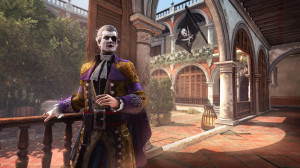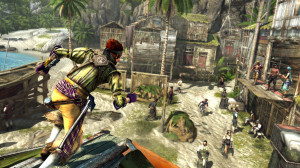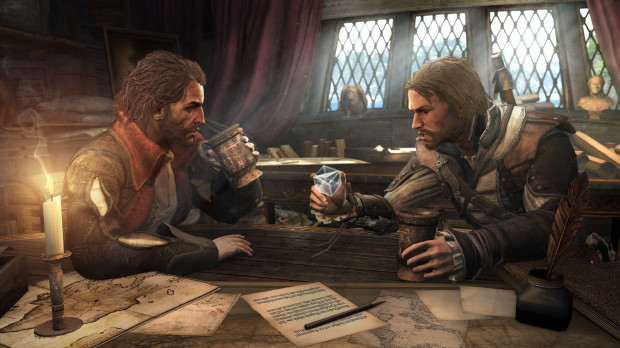Assassin’s Creed 4: Black Flag Review
This game was reviewed on the PlayStation 3.
Assassin’s Creed has always been a hit-or-miss franchise with me. Better to the point, aside from the first release, I logged perhaps an hour total between the other four iterations of the series, and that’s a generous estimate. So it surprised me that not only have I really enjoyed Assassin’s Creed IV: Black Flag, but that I enjoyed it so much that I spent almost a good 20 hours playing it for the Extra Life event alone!
Assassin’s Creed IV: Black Flag is a third-person action adventure title from Ubisoft. It is the first game in the series that doesn’t feature the modern-day protagonist, Desmond Miles, as it takes place after his death in Assassin’s Creed III. Instead, you play as the nameless, faceless new employee at Abstergo Entertainment. Your task is to explore the Caribbean as a colonial-era pirate by the name of Edward Kenway. It’s this Animus-bound alter-ego that you spend the majority of your time as, splitting your experiences between your quest to find the Observatory, a Precursor artifact, and taking to the high seas to plunder ships filled with treasure, take over fortresses, and expand your empire!
 Like the previous games in the Assassin’s Creed series, Black Flag is an open-world game that combines action, stealth, and exploration. The main story and side quests consist of a myriad of tasks including the traditional eavesdropping and assassination missions, and has a ton of collectibles lying all over the world to pick up. Some new features have been added to keep things fresh. Treasure hunting has been extended to the ocean floor where you can dive shallow wrecks in search of plunder, including blueprints that can upgrade the Jackdaw, your pirate ship. Ocean fortresses can be taken from the British Colonials to provide you safe harbors from your enemies on the water. The retooled notoriety system now works much like a GTA-style game where sinking ships will increase your level, eventually gaining you the attention of hunter ships that run you down. If you find the waters growing too uncomfortable, however, you can always visit gentleman in various ports capable of taking care of your reputation – for a fee of course.
Like the previous games in the Assassin’s Creed series, Black Flag is an open-world game that combines action, stealth, and exploration. The main story and side quests consist of a myriad of tasks including the traditional eavesdropping and assassination missions, and has a ton of collectibles lying all over the world to pick up. Some new features have been added to keep things fresh. Treasure hunting has been extended to the ocean floor where you can dive shallow wrecks in search of plunder, including blueprints that can upgrade the Jackdaw, your pirate ship. Ocean fortresses can be taken from the British Colonials to provide you safe harbors from your enemies on the water. The retooled notoriety system now works much like a GTA-style game where sinking ships will increase your level, eventually gaining you the attention of hunter ships that run you down. If you find the waters growing too uncomfortable, however, you can always visit gentleman in various ports capable of taking care of your reputation – for a fee of course.
Riding the high seas and taking ships (or sinking them) is the primary method of earning your living. Using your spyglass, you can view a ship’s statistics, including its cargo. Once the decision is made to attack, you can run down ships using an array of weapons including mortars, cannon, and a battering ram. Bring down the ship’s health enough, and you’ll be able to board the ship, allowing you to kill enough crew or complete mini-objectives such as killing the officers or setting off powder kegs. Of course, if you so decide, you can just sink the ship. Unfortunately, taking that course of action will result in only half of the plunder. As you make your ship bigger and better, you’ll find bigger ships to pick on, including “legendary” class vessels, which are First-rate ships of the line. Massive vessels with 45-5o cannons per side that can swat an early level version of the Jackdaw like a third-rate fly.
 Community events, globally ranked events that appear in the single-player instance, are also available for you to partake in. These events include chasing down convoys of ships worth thousands of reals (colonial Caribbean currency), hunting rare animals such as the infamous white whale of Melville’s Moby Dick, assassinating enemies, and more. The more you participate in these events, the higher your global ranking. These events, along with the constant quest to find the hundreds of collectibles in the game, are almost guaranteed to net you well over 50 or 60 hours of game time in the single-player campaign. Of course, the sheer fun of just being a pirate and chasing down ships to plunder will probably net you well more than that. But if you’re seeking even more variety, there’s always the multiplayer portion of Assassin’s Creed.
Community events, globally ranked events that appear in the single-player instance, are also available for you to partake in. These events include chasing down convoys of ships worth thousands of reals (colonial Caribbean currency), hunting rare animals such as the infamous white whale of Melville’s Moby Dick, assassinating enemies, and more. The more you participate in these events, the higher your global ranking. These events, along with the constant quest to find the hundreds of collectibles in the game, are almost guaranteed to net you well over 50 or 60 hours of game time in the single-player campaign. Of course, the sheer fun of just being a pirate and chasing down ships to plunder will probably net you well more than that. But if you’re seeking even more variety, there’s always the multiplayer portion of Assassin’s Creed.
Wolfpack and Adversarial modes return to the forefront of Assassin’s Creed IV‘s multiplayer components. For those unfamiliar, Wolfpack is a cooperative game mode where you and your team must complete a series of memory sequences of increasing difficulty by performing assassinations alone, or cooperatively. Adversarial is a competitive game type where you’ll hunt after your fellow assassins through the crowded streets of familiar ACIV locales, while they attempt to take you down as well. For the creative types, there is the Game Lab, where you can create custom game types to play, and submit them to be used in the public arena.
Assassin’s Creed IV: Black Flag is one of the titles that is bridging between the console generations as it has launched on the PlayStation 3 and Xbox 360, and will also be a launch title for the PlayStation 4 and Xbox One. Fortunately, this game has not suffered at the hands of the future consoles in its creation as we have seen with other titles such as CoD: Ghosts and Battlefield 4 in that the in-game graphics on the current generation of consoles are simply beautiful. Ubisoft has managed to really create a world full of lush tropical habitats and small villages that you would expect from an 18th century Caribbean region. Having seen the game running in full 1080p on the next-gen, the games look almost identical from a calibrated eyeball perspective, with the newer-gen sporting a wider array of color and a rock solid 60 frames per second.
But when you’re sailing from one end of the Caribbean to the other, scenery at times can be sparse. Fortunately, along with Brian Tyler’s superb compositions providing the bulk of the soundtrack for Assassin’s Creed IV, sea shanties fill those long gaps in between the action on the high seas. These songs of olde (which can be collected throughout the game to extend your library) are a delight to listen to, so much so that you just might get them stuck in your noggin.
In the beginning, I was apprehensive about where Assassin’s Creed IV: Black Flag was going. It was all too easy to crack jokes about “Pirates’ Creed: Assassins of the Caribbean” as I often referred to it before its release. Pirates, after all, are just as easily becoming overdone as zombies have. The only complaint, however, that I really have about the game is actually about the controls. Like every game before it, the controls suffer at the hands of all of the things you are capable of doing. All too often I’ve been run down by dozens of British troops because I steered my character a little too close to that pile of palm leafs and Kenway just had to dive in. Or I would be running down a foe that had some information that I needed and he would get away because Kenway had to stop and perch on top of a fence post for a few minutes. You would think that this would be something that Ubisoft would have solved by now. But, if you’re like me, and have found the second through fifth installments of this franchise lacking, you might want to take a look at this one.
About This Post
